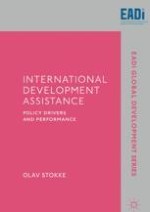2019 | OriginalPaper | Buchkapitel
9. The United States: The Realist
verfasst von : Olav Stokke
Erschienen in: International Development Assistance
Aktivieren Sie unsere intelligente Suche, um passende Fachinhalte oder Patente zu finden.
Wählen Sie Textabschnitte aus um mit Künstlicher Intelligenz passenden Patente zu finden. powered by
Markieren Sie Textabschnitte, um KI-gestützt weitere passende Inhalte zu finden. powered by
